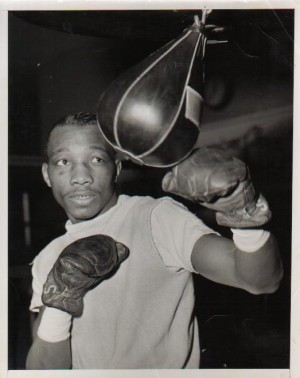“In our last fight Pep kept standing on my toe,” complained Saddler. “It hurt like hell and I yelled at him to stop. What did he do? He kept on doing it through the rest of the fight.”
The ensuing brawl, in which the fighters gouged, butted, wrestled and at one point even attempted to strangle one another, led to both men being banned by the New York State Athletic Commission. Saddler’s licence was suspended for 60 days and Pep’s for life, although it was subsequently reinstated within two years. “I thought I fought a clean fight,” remarked Saddler innocently.
Yet even world heavyweight champion Rocky Marciano, whose own roughhouse tactics were legendary, called the contest “the roughest, dirtiest fight I have ever seen”. In the ensuing uproar, referee Eddie Miller testified that the disgraceful conduct of Pep, who was of Italian stock, and Saddler, a West Indian, had made him fear a race riot.
Although Saddler won three of those four vicious showdowns, he could never quite escape Pep’s shadow, remaining particularly bitter about the fact that his old rival continued to be hailed as an all-time great while he himself was relatively forgotten. Paradoxically, it was Saddler who would eventually retire as undefeated world champion, while Pep could still be found fighting in small hall shows in his mid-40s, a shadow of his former self.
Born in Boston, Massachusetts, Joseph Saddler was, at 5ft 8.5in, something of a featherweight freak who exploited his exceptionally long reach to the full. Raised in Harlem, New York, he had around 50 fights as an amateur before turning professional at the age of 17.
A dynamic puncher with both hands and an enthusiastic exponent of the left jab, Saddler was a veteran of almost 100 fights by the time of his first world title fight against Pep, a consummate ring artist who had lost just once in 136 fights. Although Saddler later claimed he fought for little more than training expenses, he caused a major upset by knocking out the overconfident champion inside four rounds at New York’s Madison Square Garden on October 29 1948.
Pep produced perhaps the greatest performance of his career to regain the title on points before a capacity 19,000-strong crowd at the same venue on February 11 1949, but Saddler won their third meeting, at New York’s Yankee Stadium, by an eighth-round knockout on September 8 1950 and promptly branded his opponent “a quitter”.
This remark helped fuel the rancour surrounding their fourth fight. That contest ended after the ninth round, when Pep, who was badly cut over the right eye, retired. One of Pep’s cornermen urged the referee not to intervene, and the fighter momentarily seemed on the verge of punching his own handler.
Saddler’s third victory underlined the extent to which he had the measure of Pep, although he was unable to capitalise fully on this, as his career was then interrupted by a three-year stint in the army. The aggressive New Yorker, whose 103 knockouts in a 162-fight career cemented his reputation as a fearsome puncher, returned to recapture the nine-stone crown by outpointing Teddy Davis on February 25 1955. Having stopped Flash Elorde in San Francisco on January 18 1956, Saddler was still world champion the following year, when he was forced to retire because of an eye injury suffered while travelling as a passenger in a taxi that crashed. Having been warned that he risked blindness, Saddler closed a 12-year career in which he lost on a mere 16 occasions, with two draws.
Saddler, who went on to train world heavyweight champion George Foreman in the 1970s, ended his feud with Pep by boxing a one-round exhibition contest with his great adversary in 1973. By then Saddler was 47 and Pep 50, but Saddler still took umbrage over the fact that Pep was introduced first.
Elected to the Hall of Fame in 1990, Saddler suffered a savage beating in a street robbery and latterly developed Alzheimer’s disease. His final years were spent in a nursing home; he is survived by a son, as well as his perennial foe Willie Pep.


